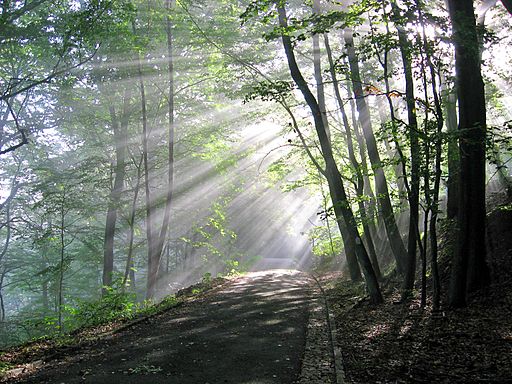| By Lokilech (Own work) [GFDL (http://www.gnu.org/copyleft/fdl.html), CC-BY-SA-3.0 (http://creativecommons.org/licenses/by-sa/3.0/) or CC-BY-SA-2.5-2.0-1.0 (http://creativecommons.org/licenses/by-sa/2.5-2.0-1.0)], via Wikimedia Commons |
Beautiful light is the key to landscape photography. Without it there is no picture - or at least there is only an ordinary image to be obtained. have a look at the scene on the right. The subject is a fairly ordinary country lane running through a small wooded area. There is nothing very remarkable about the basic scene or composition of the image.
Now have a look at the light! The rays of light streaming in through the trees on the upper right-hand side of the image have created a stunning array of "Jacob's ladders" - an expanding fan of soft diverging rays of sunlight descending to the ground to create small pools of illumination. The appearance of the rays is sometimes enhanced by the presence of local mist - here, perhaps hanging in the trees.
There are three main characteristics of light encountered by landscape photographers - quality, temperature and direction. Light may be harsh on a clear sunny day, or soft on under an overcast sky which acts like a giant softbox. The colour temperature of the light also varies during the day. It is generally a warm red or orange at sunrise, neutral during the middle part of the day, and warm turning to blue around dusk. Finally, a scene may be illuminated from the front, the side or the back. Every combination of these basic characteristics produces a different effect.
Using light is, however, not just about being aware of how the three basic qualities present themselves at a particular moment. The best images are created by finding extraordinary lighting effects which transform a scene from beautiful to mind-blowing. There is no formula for achieving this other than spending a lot of time in areas with the potential to produce wonderful images. Landscape photographers do not get up two hours before dawn because they cannot sleep. They get up early because they know that the most extraordinary lighting effects are likely to reveal themselves around dawn and sunset. However, even this is not a golden rule. The sun may unexpectedly burst through a hole in heavy storm clouds that seem to make landscape photography a waste of time, and for a few glorious moments turn a dull and uninteresting scene in to a magical light show. Such events are relatively uncommon. They do not occur every day or every week, and may be gone in a matter of seconds. But to capture them a photographer has to be out and about at the optimum times of day - an carrying a camera!







